How Do You Paint Frond Palm Masks What Paints Do You Use
African patterns
An ode to my profession...
Africa has a wealth of patterns, everywhere you await you volition see repetitions of shapes and colours, textures and lines laid out in all sorts of arrangements.
So what is so interesting about patterns?
Besides being so visually highly-seasoned, I run across blueprint making in Africa a s an innate affair, akin to rhythm: The pounding of maize in a bowl feels the same equally the stamping of paint on fabric..... the weaving of hair braids is the aforementioned soft rhythmic exercise as plucking at an mbira.
Take a bulldoze anywhere in Africa and wait for patterns; annotation the decorated houses, see how the road stall is set out in product groupings defined by colour or shape. Look at the woman across the street... s ee the woven, patterned basket she carries on her head, observe the colourful, printed or dyed fabrics used to clothe her.
Notice the precise, rhythmic rows of her hair braids, sometimes intricately decorated with their own recurring patterns.
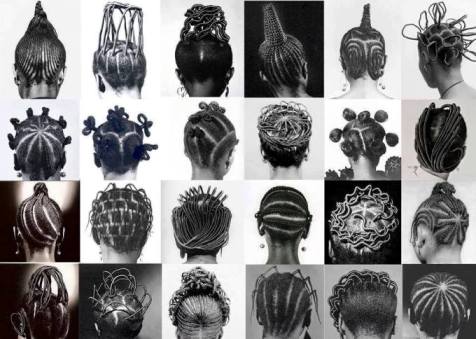
Information technology seems to me that these photos of textures in the sand could exist reflective of those braids.... or the other style round?
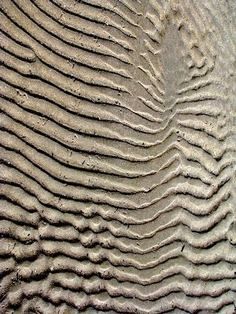
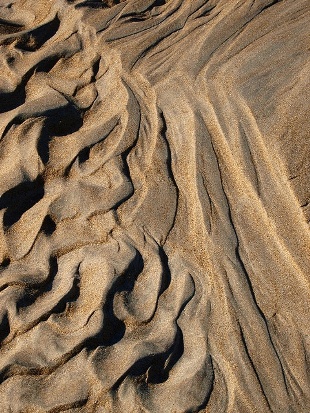
In nature, and all around us in Africa, there are patterns that can be visualised or conceptualised. On the land, observations of botanical items like leaves, trees, thorns, pods and seeds reveal elegant shapes, lines and patterning. Deeply thrown afternoon shadows from trees and rocks lend themselves to cute intricacies of pattern. So, too, practise the cover-up markings on animals, birds and insects.
Deep river waters make whorls and eddys and at the bounding main, waves create textures in the sand. Body of water shells and fish have beautiful intricate patterning for adornment and coral creates crazy outline shapes. And so much reference to utilise as a source!
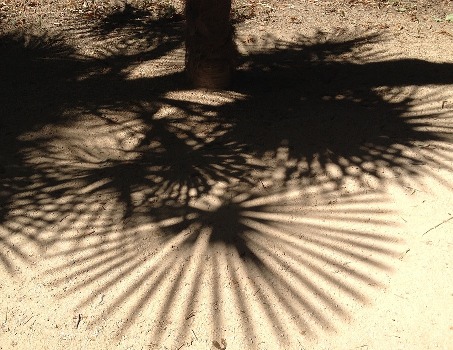 Palm shadows
Palm shadows
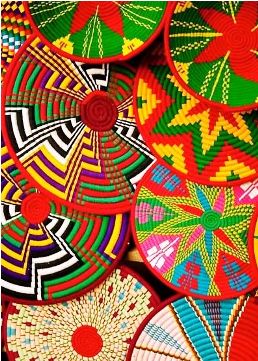 basket patterns
basket patterns
The fan of palm leaves in shadow remind ane of the spread out fan shapes seen both outside and within these round, woven placemats.
Observe all of these details, overlay a sense of rhythm and yous volition detect repetition of form and shape (patterns) ..... in everything!
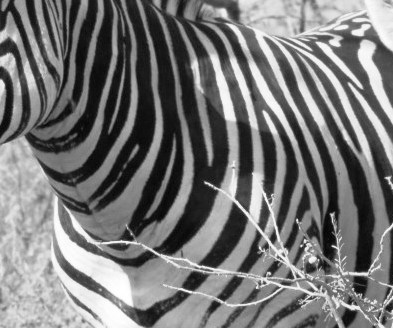 zebra patterns
zebra patterns
Produced in Zimbabwe, these original and unusual mosaic tables featured above have used both animal, reptile and geometric sources for the Africa-inspired,Africa Drove.
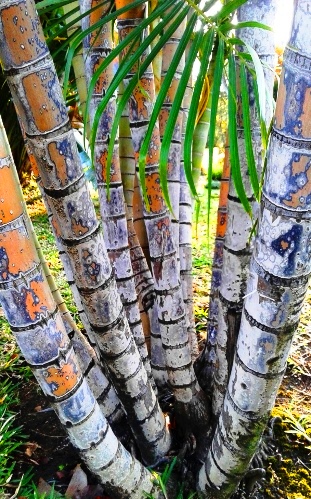 Palm trunks
Palm trunks
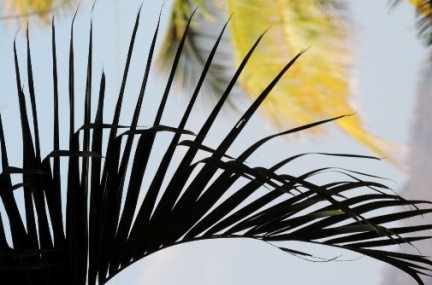 Palm frond
Palm frond
Tutsi basket patterns seem to me to have been derived from palm trees, either the fronds or the markings on the stalks which occur rhythmically at intervals.
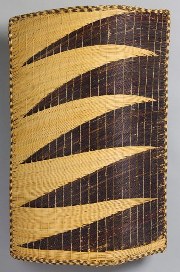 Tutsi screen
Tutsi screen
Pattern styles and motifs may change from culture to culture, providing insight into personal manner and culturally specific aesthetics.
Add pregnant to some of the symbols, colours and shapes used in diverse surface effects and you have a complicated and challenging topic to explore to any level you lot care to!
Types of Pattern
These generally fall into 2 groups:
- Geometric -Linear and organic: Diamonds, triangles, lozenges, triangular or square chequerboard, parallel zigzags, chevrons, dots, circles, curved lines or waves, spirals
- Symbolic -Natural or man-made representative motifs: Includes cruciforms, crescents, stars, mosaics, flowers, fruit, seeds, pods, copse all used emblematically.
Symbols are visual expressions of a society's culture; its philosophy, beliefs and history. They may be rich in proverbial significant and frequently signify the collective wisdom of the tribe. They can communicate knowledge, feelings and values and therefore play an important office in Africans' concept of reality.
They can depict anything from animal and human behaviour to important events, or they can simply reflect their surroundings and various aspects of their lives in shapes and emblems.
Some are quite literal in their translation merely others are representative, not representational.
Even if its a recognisable shape like a palm tree, there volition be meaning behind its inclusion in a design and what it adorns. For case, like the palm tree which represents self-sufficiency but is used to highlight the notion that human being beings are the opposite - that they are not self-sufficient!
Common patterns
Parallel zigzags reminds the viewer to obey the 'path of the ancestors', often used to represent the fact that nothing in life is straightforward and the path will exist difficult to follow.
Chequerboard black and white triangles, or squares, represent the separation of knowledge and ignorance. White represents the beginning of process of learning and blackness, the accumulation of wisdom.
An case of where symbolic motifs and emblems are vigorously used are by the Ashanti tribes of Ghana and the Gyaman of Cote D'Ivoire who employ motifs to fabric, pottery and newspaper - visual representations of concepts and idioms.
Adinkra robes, seen here beneath worn past two Ashanti men, are stamped with motifs in various patterns that accept symbolic significance and tell a story or recount a maxim.
The important thing to remember is that they are constantly evolving and new influences in electric current societies are reflected in new motifs.
Being enlightened of, and having understanding of the nature and role of symbolism as a form of advice in both current and historical cultures will assist provide understanding of the blueprint of thoughts and feelings of contemporary African cultures.
History of pattern
Our main source of historical information about African pattern and design comes from architecture, decorated artifacts, masks and textiles.
The fashion of patterning on architectural ruins and remains can give us significant insight into the building and the occupational history of a structure.
Historically, many forms of mathematical geometric variations have occurred in both repetitive border and all-over patterns.
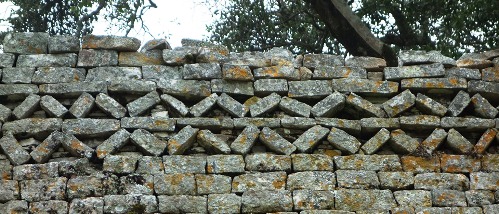 Chevron stone pattern, Great Zimbabwe
Chevron stone pattern, Great Zimbabwe
Chevrons and zigzags exist in just well-nigh every class and facet of African decoration.... like in the wall structures of the ruins of Great Zimbabwe or the Asante stool seen above.
Geometric shapes of diamonds and triangles are probably the most common shape for apply in a multitude of ways; painted, incised, scraped, embossed, printed, embroidered... y'all name information technology. Arranged repeatedly in vertical or horizontal rows, they can be interchanged or scaled upwardly or down for dramatic effects similar the pattern beneath.
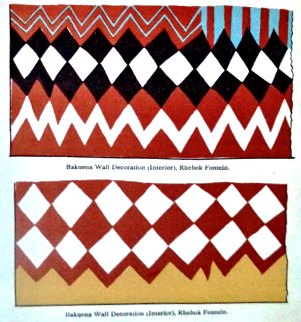 1905, wall-decoration, SA-patterns
1905, wall-decoration, SA-patterns
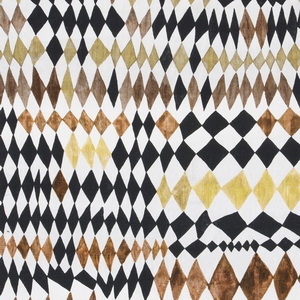 "Mali', color 'dune', Hertex fabrics
"Mali', color 'dune', Hertex fabrics
Here, an antiquarian document recording wall patterns from 1905 is used equally a resource for a gimmicky African textile blueprint.
Sadly, in this modern era, a lot of the meaning and historical significance of various shapes or motifs is lost to u.s.a. and can only be conjectured about.
But in some cases, like information technology is withAdinkra printed fabric orKente woven textile, the meanings of the selected colours or motifs used in the blueprint have been passed down from generation to generation. The symbolic connotation is meaningfully applied past the artist... and comprehended by the wearer.
The style of patterning on the garments, robes, body wraps and aprons that adorn certain tribes can likewise give us significant insight into their social and religious backgrounds.
The women of East Africa took evidently white slave cloth as a blank canvas for embellishment, creating hand-painted variations which were ofttimes strongly patterned to make a social statement and elevate their status.
Similar in the old photographic print beneath, the garments frequently featured bold designs executed in a black, paste-like paint that was mixed from natural sources similar barks and roots, black soot and kokosnoot oil. Motifs were generally derived from recognizable images, mainly plant (like the cashew nut-the paisley shape and associated with wealth) or graphic geometrical shapes making for extremely hitting apparel.
Bold design either painted, embellished, carved or etched is a powerful and expressive component of African mask blueprint. Most patterns tend to be geometrical and symmetrical and often provide distinguishing marks for identifying whether the mask is male or female.
Patterns on masks and textiles were used every bit a form of identity for tribes and outsiders could be hands identified if their masks and robes were foreign to the area.
Apply of patterns
All over Africa there is an overwhelming sense of design and an underlying construction of consequent and recurring blueprint.
Patterns are used in the decoration of:
- Compages-walls, roofing, doors, columns, finials, tiles, ceramics
- Functional objects-baskets, pottery, article of furniture, musical instruments
- Adornment-jewelry, amulets, hair, combs, body painting and scarring, tattoos
- Artifacts-carved, painted, embellished (beaded, cowrie shells, seeds, pods,metal, leather)
- Textiles-woven, printed, tie-dyed, stamped, embroidered, sewn on, appliqued
Architecture
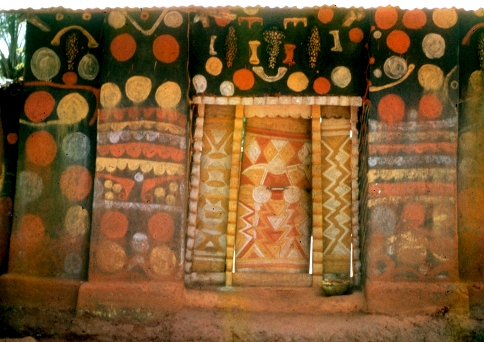 Portal-Ozo, Igbo, 1966
Portal-Ozo, Igbo, 1966
The building to the left shows blueprint ornament both painted and in relief. The other image shows an unusual painted circumvolve design and busy doorway from the Igbo tribe, circa 1960's.
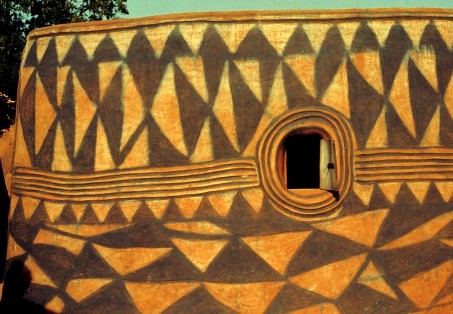 Painted wall, Frafra domicile, North Ghana
Painted wall, Frafra domicile, North Ghana
The solid Adobe houses above are from Northern Ghana.
The Frafra people paint their traditional Gurunsi mud houses with strong geometric patterning forth with constructing undulating walls, curved doorways and round windows making for an intriguing looking dwelling!
The Ndebele women of Zululand, NW Southward Africa have been decorating the walls of their houses and compounds for generations- a tradition calledukugwala which showed their design power as worth of a good wife.
In the 18th C they painted their walls with their fingers, dragging them through wet clay plastered on to the wall surface to create undulating or straight lines in geometric groupings.
The circuitous murals of today just started relatively recently in the 1940's when Ndebele women began to have admission to commercial paints.
Ndebele mural designs tin can communicate information almost a family'southward history and identity.
The about vividly coloured patterns had the same style as that seen in their beaded jewelry, aprons and other utility items.
Artifacts & Arts and crafts Items - functional and not-functional
Beaded items
Cache-sex or female beaded aprons show exquisite designs and patterning. The geometric elements are beautifully arranged in sophisticated combinations of both shapes and colours.
Baskets
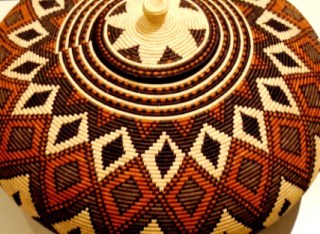 Botswana, Tatham Gallery
Botswana, Tatham Gallery
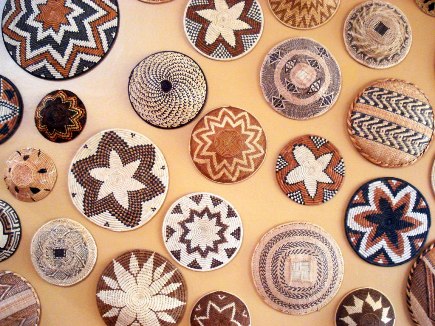 Wall of baskets, floral design, Zim Nat Gallery
Wall of baskets, floral design, Zim Nat Gallery
Some basket patterns have evocative names like "Running Ostrich', 'Ophidian Stomach', 'Wings of a Bat' and 'Ribs of a Giraffe'.... likewise 'Forehead of the Kudu' or 'Brow of the Zebra'.
'Running Ostrich' is also known as the marks made from a bicycle tire... in modern times it is difficult to know if the names of the patterns have carried down the line with their meaning intact or if they have been re-interpreted.
Carved Items
Doors, headrests, walking sticks, combs, boxes are all items that lend themselves to detailed carving and decoration.
Headrests exhibit very personal style since they are such individual used objects but they besides have design elements that are repeatedly used throughout Southern and Central Africa - peculiarly thendoro(the concentric circle motif that bears reference to the base of the white conus-trounce, a valued status symbol).
Other motifs used like the triangles, keloids and chevrons deport reference to the scarifications which were traditionally exhibited on both African males and females.
Some artifacts are incised with relief etching similar the Shona headrest and some accept carving as well as being masterfully sculpted into 3 dimensional forms like both the stools above.
Masks
Most designs on masks tend to be geometrical and symmetrical. Mask patterns can denote social status and accept magical or spiritual powers. Patterns are combined to convey the rules for proper acquit in the tribe and the requirements of the spirits that the masks correspond and are therefore a powerful course of communication.
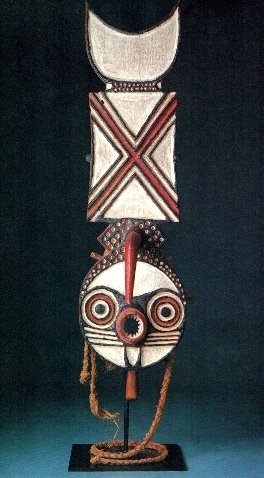 Bwa mask, Volta region
Bwa mask, Volta region
Colour can determine regional and tribal characteristics and styles.
The Voltaic people of Ghana use red, white and black colors to their masks in intricate geometrical patterns with symbolic significance..... as do the Bamileke of Cameroon.
Textiles
Of all the genres by which patterning is exhibited in Africa, textiles carry the most exciting and well-nigh complex grade of repetitive pattern.
Kente or Ashanti material from Ghana has over 300 different traditional patterns. As the cloth is woven in strips and then sewn together, the design possibilities for a finished slice are countless.
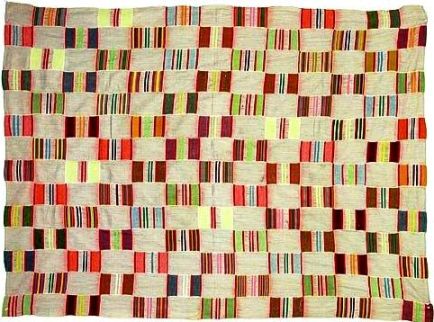 Kente quilt
Kente quilt
Both the use of color and the selection of motifs or symbols will have their own connotations and, of grade, unlike combinations of these volition say dissimilar things in a design. Normally there is more one colour and one pattern found in a unmarried piece of fabric but sometimes, information technology tin can be just 1 with a detail message to go beyond.
Kuba (Bushoong) material - from an early on 20th C style, can have very graphic patterning and will always have different elements to it every bit it is generally made up of 3 panels. The borders tin mirror each other or be asymmetrical just they are generally more complicated than the eye.
The middle panel appears abstracted with a assuming arrangement of appliqued cloth in a contrasting colour but the motifs appear quite randomly placed and conduct names like 'tail of a dog', 'circles' and 'leaves' to correspond to the abstracted shape they represent.
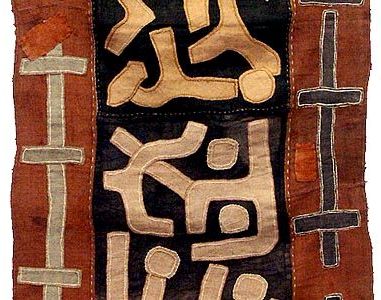 Kuba cloth, Zaire
Kuba cloth, Zaire
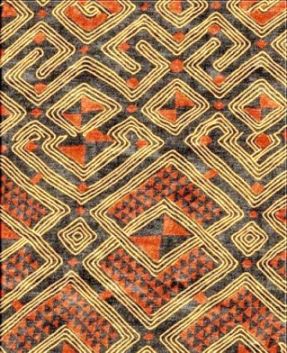 Kuba shoowa cloth
Kuba shoowa cloth
Shoowa material is very structured in comparing and has dense and rhythmical patterning with overcast embroidery and cut-pile designs.
Kuba Raffia fabric is a highly patterned unmarried colour cloth made from sewn strips and squares of woven raffia cloth which has been embroidered with dyed raffia threads in all sorts of geometric shapes in interlaced and intertwined combinations.
For further insight and information into African textiles click here
Methods of applying Pattern
There are various methods of applying and making patterns:
- Press (stencils, stamps, sticks)
- Painting (walls, ceramics, material, artifacts, article of furniture, masks)
- Weaving (cotton, silk, man-made and natural fibres, metal)
- Sewing (embroidery, applique, objects)
- Resist (tie-dyeing, pastes, stitching)
- Carving (etched, incised)
- Sculpting (wood, clay)
Mbuti barkcloth, (known also as Pongo cloth), is an artistic expression of the singing adult female foragers of the Ituri wood in NE Zaire.
Practical in an abstruse fashion to pounded bark fabric the artists paint rhythmical free-oscillating patterns using sticks and natural dye made from black carbon and Gardenia juice. The patterns are very frequently the aforementioned equally those designs that they apply in trunk painting.
It seems to me to be a very fitting identify to sign off on this huge page that is African Patterns as these barkcloths exhibit dandy spontaneity and musicality in their designs.
Abstract rhythms and deliberate contrasts are built up by leaving areas of stillness and quiet between the horizontal and longitudinal lines and the expressive free-flowing motifs that embrace the fabric.
Each is a composition all of its ain and it fascinates me that seemingly the most primitive works can have patterns that are enigmatic, intriguing and as reductive as the well-nigh sophisticated abstract artist who seeks to refine and define by systematic mark-making.
* Pattern making by artists/artisans/designers and architects in the gimmicky African world tin can exist viewed on this page
Source: https://www.contemporary-african-art.com/african-patterns.html
Posted by: woodruffturitch.blogspot.com


0 Response to "How Do You Paint Frond Palm Masks What Paints Do You Use"
Post a Comment